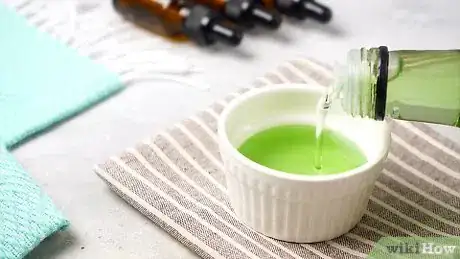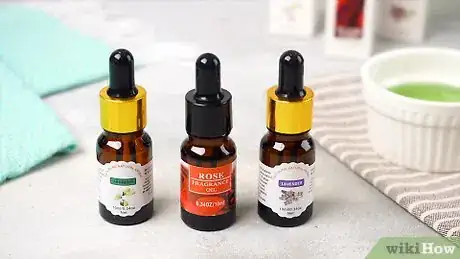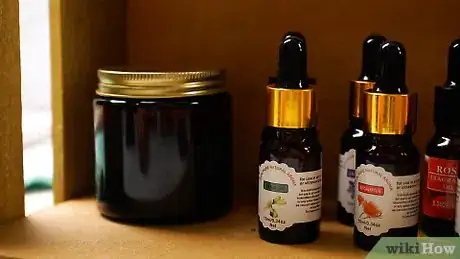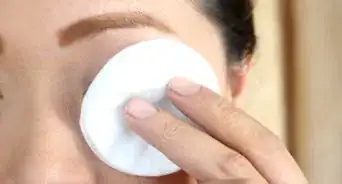This article was co-authored by Barbie Ritzman and by wikiHow staff writer, Sophia Latorre. Barbie Ritzman is a Beauty Specialist, Influencer, and the Owner of Barbie’s Beauty Bits. With over 10 years of experience in the beauty industry, she specializes in skincare and aesthetics. Barbie studied marketing at Tidewater Community College and holds a Certificate from the Media Buying Academy. For her work, she’s won Beauty Influencer of the Year - The USA and was featured in “The Allure 50,” which includes the year’s 50 most influential people in the beauty industry.
There are 13 references cited in this article, which can be found at the bottom of the page.
wikiHow marks an article as reader-approved once it receives enough positive feedback. In this case, 89% of readers who voted found the article helpful, earning it our reader-approved status.
This article has been viewed 152,223 times.
Scrumptious-smelling body oils are perfect for hydrating your skin and giving it a beautiful shine, and they’re heavenly for massages, too. Before you dash over to the department store and spend your cash on a commercial product, try making your own fragrant body oil at home. All you need is a carrier oil, a few essential oils, and a dark bottle. The oil you mix up is perfect for self-care and also makes a great gift.
Steps
Oil Selection
-
1Pick a carrier oil. You must dilute essential oils with a carrier oil before applying them to your skin. Some good fragrance-free options include avocado, sweet almond, jojoba, grapeseed, and apricot kernel oil, but they do need to be refrigerated.[1] Alternatively, pick olive, coconut, argan, or sesame oil as your carrier, all of which are safe for your skin.[2]
- Choose cold-pressed or organic carrier oils whenever possible.[3]
- Sweet almond oil smooths the skin, helps combat dehydration and dryness, and even has a pleasant scent. It's a great choice for all skin types.[4]
- Sunflower oil is very soothing since it contains fatty acids. It's also rich in protective antioxidants, which are excellent for anti-aging.[5]
- Cold-pressed, unrefined extra virgin olive oil locks in moisture and hydrates your skin.[6]
- Always do a patch test beforehand. Dab a drop of the oil onto your inner wrist, and wait at least 24 hours to see if there's a reaction.[7]
-
2Choose a bright essential oil for the top note. You can make a simple body oil with 1 essential oil and 1 carrier oil. However, many people prefer to make their own customized mixes. To start with, decide on a "top note" for your perfumed body oil. This is a bright or sharp aroma that will grab your attention when you first smell the mixture, but it will not last long.Advertisement
-
3Select a complex scent for the middle note. Also called the heart note, this oil usually has a full-bodied, complex scent that lasts 1-2 hours on a perfume testing strip. You can choose a middle note to serve as the main theme of the scent. Alternatively, pick one that shares elements of the top and base notes so all 3 scents harmonize.[10]
- Good choices include chamomile, ginger, rose, lavender, geranium, and other herbal and flowery scents.[11]
-
4Opt for a deeper base note. For a classic 3-note mix, the last essential oil you'll need is the base note. This should last at least a few hours, as its main purpose is to give the blend staying power. Many oils used as base notes are also fixatives, which slow down the rate of evaporation of the other scents.[12]
- Try deep, strong scents such as vanilla, cocoa, sandalwood, patchouli, or frankincense.
-
5Tweak your combination as needed. Once you've made your 3 choices, put a couple of drops of each on a cotton round, and waft the scent toward you for a test. If you're not a fan, swap out one or more oils with a different scent.[13]
-
6Do a patch test to make sure you don’t have a bad reaction. If you haven't applied 1 or more of your chosen essential oils to your skin before, do a patch test. This is especially important if you are taking medication or if you have known allergies. Use this procedure:[14]
- Dilute your essential oils in a carrier oil to twice the concentration you plan to use.
- For instance, if you plan to use a 3% mixture, dilute it to 6% for the test, which would be 6 drops of the essential oils in 1 teaspoon (4.9 mL) of the carrier oil.
- Wet the inside of a bandage with the mixture and place on your inner arm.
- Remove the bandage after 48 hours. If there is any redness or itchiness, do not use that oil.
- Dilute your essential oils in a carrier oil to twice the concentration you plan to use.
Body Oil Mixture
-
1Use small, dark glass bottles to store your oil. Sunlight and air break down oils over time. Store your oils in bottles made from dark, semi-opaque glass, the size of a small perfume bottle. The small size lets you work with quantities that you can use up before they break down while minimizing headspace (air inside the bottle) that speeds up decay.[15]
- Use bottles with a tight cap or cork.
-
2Measure the size of your bottle. Fill your bottle with water nearly to the top, then pour it into a measuring cup. Write down the number of milliliters the bottle holds. Multiply this number by 20 to get an estimate of the number of drops that fit in the bottle.[16]
- For example, if you plan to make a large batch of 50 mL, your bottle holds 50 mL x 20 drops/mL = 1,000 drops.
- For reference, 1 US fluid ounce is close to 30 mL.
-
3Dilute the essential oils to 1-5% for safety. If you're an adult that plans to use the body oil across a large area of your body, dilute the essential oil to 1%. If you plan to use it as a perfume or for a small area, you can safely try 3 or 5%.[17] For a 1% dilution, multiply the number of drops your bottle holds by 0.01.
- For example, if you have a 1,000-drop bottle and plan to dilute to 1%, you'll need 1000 x 0.01 = 10 total drops of essential oil.
- Expensive essential oils are often sold in diluted form to make them affordable. If the label says it's already 5% diluted, multiply the number of drops by 20 (since 100% ÷ 5% = 20%).
-
4Use 2 parts of the base note, 1 part of the middle note, and 2 parts of the top note.[18] This ratio uses 5 "parts" total (2 + 1 + 2). If you’re making a 1% essential oil mixture in a 50-mL bottle, you’ll need 10 total drops of essential oil, or 2 drops per part (because 10 drops ÷ 5 parts = 2 drops per part). Here’s how to divide that up between the 3 scents:
- 2 parts base note x 2 drops/part = 4 drops base note.
- 1 part middle note x 2 drops/part = 2 drops middle note.
- 2 parts top note x 2 drops/part = 4 drops top note.
- Sometimes the math doesn't work out neatly, and you can't get a perfect ratio. Just get as close as you can.
- This isn't the only recipe you can use. If you want your middle note to be the centerpiece, you can go as high as a 1:3:1 ratio.[19]
-
5Mix together your essential oils in the bottle. Count out the drops of each essential oil according to the calculations you just did. Add these all to a glass bottle, and swirl it around so they mix together.
-
6Fill the rest of the bottle with your carrier oil. Since all that math was based on the size of the bottle, you don't need to count out the drops. Just fill the bottle up with carrier oil as full as you can. Close the lid tightly and shake for a minute or 2 to make sure the oils are spread evenly throughout.
- At this stage, you can smell the oil and mix in another drop or 2 of essential oil to change the characteristics. Just remember that adding too much can increase the concentration to levels that irritate the skin.
-
7Store the bottle in a cool, dark place. Seal the bottle tightly and place it in a box or on a shelf away from direct sunlight.[20] If you’re using a carrier oil that needs to be refrigerated, pop the bottle in the fridge.[21] To maximize the shelf life, transfer the oil into smaller bottles as you use it so there is never much air trapped in the bottle.[22] Keep it out of reach of children.
Community Q&A
-
QuestionCan I add vitanim E oil?
 Euna kCommunity AnswerAdd a little bit, yes.
Euna kCommunity AnswerAdd a little bit, yes. -
QuestionCan I combine a drop of Obsession and a drop of vanilla oil?
 Community AnswerYou could. First, you may want to take a small sample of it and only put it on a little bit of the perfume, so you can try it out.
Community AnswerYou could. First, you may want to take a small sample of it and only put it on a little bit of the perfume, so you can try it out. -
QuestionWhat is the function of the silver powder found in some types of fragrance oils?
 vani samallaCommunity AnswerSilver powder is an effective treatment for stubborn blackheads. This oil-absorbent powder helps unclog congested pores to prevent blackheads and promote a healthier complexion.
vani samallaCommunity AnswerSilver powder is an effective treatment for stubborn blackheads. This oil-absorbent powder helps unclog congested pores to prevent blackheads and promote a healthier complexion.
Warnings
- Consult a doctor or experienced aromatherapist before using essential oils on children and infants.⧼thumbs_response⧽
- It is possible to develop an allergy to an essential oil, even if you have used it without difficulty before. You can also get an allergic reaction from additional chemicals added to the oil, or from chemical changes that occur as the oil breaks down.[25] The safest approach is to stick with one brand for each type of essential oil, and follow the storage instructions above.⧼thumbs_response⧽
- Certain essential oils cause sun sensitivity, including many citrus oils. Avoid long sun exposure and tanning beds if you have these oils on your exposed skin.[26]⧼thumbs_response⧽
Things You'll Need
- Carrier oil
- Essential oil(s)
- Dark glass bottle(s)
- Measuring cup
- Dried herbs or flowers (optional)
References
- ↑ https://www.takingcharge.csh.umn.edu/how-do-i-choose-and-use-essential-oils
- ↑ https://www.ncbi.nlm.nih.gov/pmc/articles/PMC5796020/
- ↑ https://www.takingcharge.csh.umn.edu/how-do-i-choose-and-use-essential-oils
- ↑ Barbie Ritzman. Beauty & Skincare Specialist. Expert Interview. 23 August 2021.
- ↑ Barbie Ritzman. Beauty & Skincare Specialist. Expert Interview. 23 August 2021.
- ↑ Barbie Ritzman. Beauty & Skincare Specialist. Expert Interview. 23 August 2021.
- ↑ Barbie Ritzman. Beauty & Skincare Specialist. Expert Interview. 23 August 2021.
- ↑ http://www.edenbotanicals.com/natural-perfumery-basics.html
- ↑ https://www.takingcharge.csh.umn.edu/explore-healing-practices/aromatherapy/are-essential-oils-safe
- ↑ http://www.edenbotanicals.com/natural-perfumery-basics.html
- ↑ http://www.edenbotanicals.com/natural-perfumery-basics.html
- ↑ http://www.edenbotanicals.com/eden-botanicals-blog/fixatives-and-their-function-in-natural-perfumery/
- ↑ https://youtu.be/xbyCYZfgT6Q?t=137
- ↑ http://www.takingcharge.csh.umn.edu/explore-healing-practices/aromatherapy/are-essential-oils-safe
- ↑ https://www.fromnaturewithlove.com/library/storagefragranceoils.asp
- ↑ https://youtu.be/xbyCYZfgT6Q?t=200
- ↑ http://www.takingcharge.csh.umn.edu/explore-healing-practices/aromatherapy/how-do-i-choose-and-use-essential-oils
- ↑ https://youtu.be/xbyCYZfgT6Q?t=301
- ↑ http://www.edenbotanicals.com/natural-perfumery-basics.html
- ↑ https://www.fromnaturewithlove.com/library/storagefragranceoils.asp
- ↑ https://www.takingcharge.csh.umn.edu/how-do-i-choose-and-use-essential-oils
- ↑ https://www.fromnaturewithlove.com/library/storagefragranceoils.asp
- ↑ https://www.takingcharge.csh.umn.edu/how-do-i-choose-and-use-essential-oils
- ↑ https://www.fromnaturewithlove.com/library/storagefragranceoils.asp
- ↑ http://www.takingcharge.csh.umn.edu/explore-healing-practices/aromatherapy/are-essential-oils-safe
- ↑ http://www.takingcharge.csh.umn.edu/explore-healing-practices/aromatherapy/are-essential-oils-safe
- Cox, Janice. "Natural Beauty for All Seasons". Henry Holt and Co., 1996.
About This Article
To make body oil, start by picking an essential oil that has a bright, sharp aroma, like basil or citrus, to serve as the top note of the mixture. Next, choose a full-bodied and complex middle note scent such as rose or chamomile. Then, find a deep, strong base note oil, like vanilla or sandalwood. Once you’ve chosen your scents, put a few drops of each essential oil into a small, dark glass bottle and swirl them together. Finally, fill the rest of the bottle with a carrier oil, such as fractionated coconut oil or canola oil. For tips on how to store your homemade body oil, read on!






























































